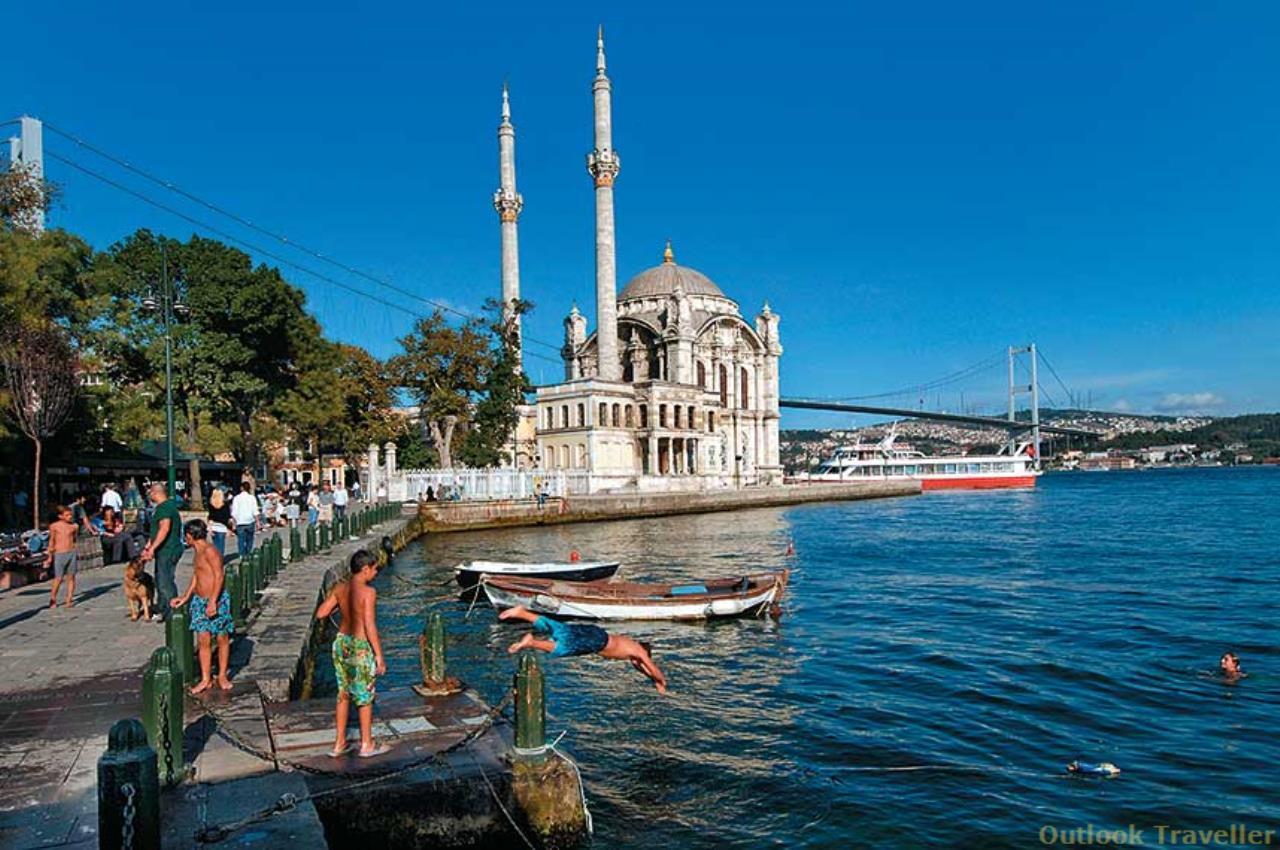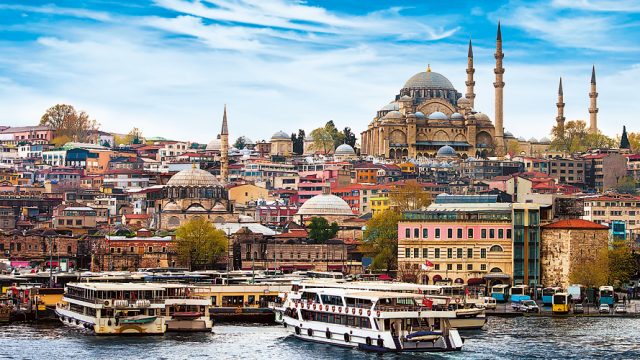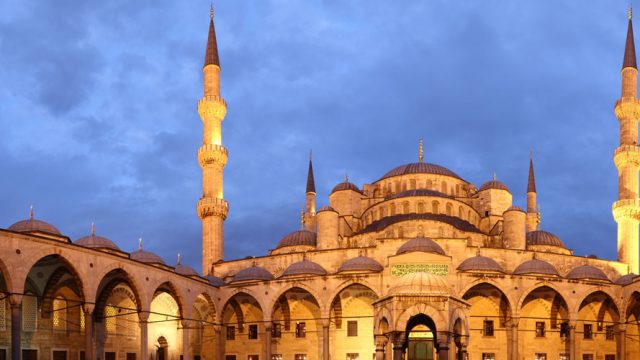It will come back to me but right now I can’t for the life of
We wandered from Taksim square (where a seedy man approached me for a light and then asked if I needed ‘night joy’) to a chattery sidewalk café in Cihangir, packed with scruffy intellectuals. After a dainty glass of Turkish black tea we moved on to the cascading patio bistros of the faux-Montmartre on ‘French Street’. “It used to be ‘Algerian Street’ before the developers moved in,” H complained. “Now no one knows about the people who lived here.” But we stopped to have a beer and listen to the troubadours anyway. We ended up on ‘Mis’ street. Untranslatable said H. But it meant something like “indescribable beautiful smell”. It was 2.30am in Pera (‘the other side’ — the old Greek name for this fabulous district) and we ordered another round of Efes lager.
Yes, yes, I was here to eat, not to drink. And I ate very well. And I will tell you what I ate in a minute. But I’ll tell you right now that it’s hard to top the evanescent charm of looping through the labyrinth of a strange and familiar metropolis (familiar in the way that all cities are familiar) with a rediscovered friend. Particularly if he’s a world-class nostalgist like yourself. Me, I was born nostalgic, and in this city I was doomed to wallow. Because I had been here before. At the grand age of 9. Memories of that vintage can have a particularly devastating effect, charged as they are with the synaesthesia of childhood — when colours have tastes and words have a smell and your mouth has its own imagination. And one thing I remembered from Istanbul was the shocking revelation of my first bite of crisp, dripping, sweet baklava. Oh, dear. My nine-year-old cortex didn’t have the vocabulary. But what it absorbed that day was the sensuousness of Decadence.
Perhaps that taste coloured my return but after four days of eating my way through the city, it was still the decline and fall I was in love with. On my first evening here, I emerged on to the 19th floor rooftop terrace of the Mikla restaurant at the Marmara Pera hotel, and my hair stood up at the spectacle of Istanbul-Constantinople spread around me like an open hand. The Byzantium that had fallen to Fatih the conqueror, the Ottoman city that had ruled half the world but never quite got over the glory of that first triumph. The pert mosques endlessly seeking to recapitulate the rounded bulk of the Hagia Sofia. The mercantile European quarter of Pera below us, which had witnessed the final descent of the Ottoman sultans into disgraced Francophile voluptuaries.
I tucked into my trakya kivircik, loin of ‘Thracian curly lamb’, grilled to smoky perfection, I slurped my ‘warm raspberry soup with vanilla ice cream highlights’ and tried to look soignée. But I was repeating a childhood mnemonic that my mother had recited to me in Istanbul:
Waiter, we are Hungary
Bring us Turkey!
Sorry we do not Serbia
Send for the Bosphorus!
Sorry he does not Romania
The trouble with mnemonics is that all you remember is the words, not the lesson. Still, I rediscovered it later in a recent book: “In 1577, for instance, no sheep were slaughtered in the Balkans — they were all driven to Istanbul instead, where, in the mid-17th century, 7 million sheep were eaten in a year, 18,000 oxen each month, 250 tons of bread in a single day. One-tenth of it all was consumed in the palace.” Jason Goodwin, ‘Istanbul — City of the Sultans’. In The Great Cities in History, Ed. John Julius Norwich.
Revisiting the Topkapi Palace, I remembered that what had impressed me at age nine was a brutal cudgel, used apparently to discipline the staff. This time round, what struck me were the factory-like kitchens, and of course the sprawling harem section. The palace was also in the news thanks to a recent scandal: a guard had been arrested for growing hashish. Ornamental, he protested! I believe him.
I remember that last supper now: before heading out to Taksim square, I had sampled an astonishingly decadent Ottoman banquet at the Tugra restaurant at the Çiragan Palace, one of the 19th-century palazzos of the late Sultans on the banks of the Bosphorus. Resurrected after a fire and transformed into a glittering hotel, it has hosted all the Pashas of our time (George Bush was here, Obama too) in suites that can run to 30,000 euros a night. Needless to say, our meal was on the house and I nibbled my way through its riches with slightly intimidated fascination. I read somewhere that neurologists have established that fine wines actually taste better if you know they are expensive. What they didn’t say is the importance of who’s paying. There were 10 varieties of mezze including pumpkin leaf dolma, lamb cooked in an earthenware jar, cracked open at the table, and a chicken stuffed with rice and creamed spinach. One meal inside another. It was all a little too recherché, too much du temps perdu. There were something like 50 varieties of baklava on offer that evening at Tugra. But none that could quite match the memory of my first bite.
At 2.30am the next day I was back in Delhi, stumbling out of the terminal into the timeless embrace of an Ambassador filled with the full-bodied bouquet of the milk run from Mahipalpur. Not indescribable at all, but beautiful in its own curdled way. I could almost taste Delhi.
The information
Old world
The hub of my trip both for atmosphere and food was the Pera area, also known as Beyoglu, on and around the legendary high street known as Istiklal Caddesi (formerly the Grande Rue de Pera) which runs between Taksim Square and the funicular station at Tünel, with countless lanes and passages snaking off on either side. It’s a pedestrian avenue, save for the picturesque vintage tram that chunters slowly down the middle of the road, bells clanging.
A number of venerable classic establishments serving Ottoman food line Istiklal, including the legendary Haci Salih (Anadolu Pasaji, Istiklal Cad 210). Hünkar be?endi (eggplant pureé) and kad?nbudu köfte (meatballs) are among the specialities. No alcohol. We had a hearty lunch of kiyamali gözleme (kheema-covered roti), kayseri mantisi (like lamb momos in yoghurt) and icil köy köftesi (meatballs in bulgar dumplings) at Hala (Istiklal Cad 131/D). Rejans restaurant (Olivio Gecidi 15, just off Istiklal near Galatasaray school) is a throwback to Pera’s days as a European enclave. Founded by Russian émigrés, it still prides itself on piroshkis, iced-lemon vodka and pork chops. Vegetarians will find succour at Zencefil, which is just off Istiklal at the Taksim end (Kurabiye Sokak No 3, Beyo?lu). Famous for its cold soups, vegetable stews and its lemonade. There are non-veg options on offer too.
For the other kind of non-veg, Pera is peppered with excellent ‘meyhane’ bars where raki accompanied by endless varieties of mezze is the preferred routine. Try Boncuk Meyhane (Nevizade Sokak, off Istiklal near the Richmond Hotel); the cigermin köftesi (‘Albanian’ liver kebabs) are essential. Also Refik at the Tünel end and the picturesque and historic Ceneviz Meyhanesi.
This is also a great place to sample some of Istanbul’s classic street food/fast food offerings. My favourites include the islak (or ‘wet’) burger at Bambi — the sauce is the secret — at the top of Istiklal in Taksim. Have a doner kebab, of course — there are good ones just across the road at Kizilkayalar but doner joints are ubiquitous. The famous tripe sandwiches called kokorec sounded a little extreme and I avoided them till my last morning. Mistake, this spicy, greasy hot baguette was one of my favourite things. Eat one at Sampion on Balik Pasaji. Another morning treat, not for everyone: the liver kebabs at Ci?ermin Kö?esi near the Galatasaray school. For baklava and other exotic Turkish desserts, including ‘ladies’ thighs’ and tavakgögusü (a chicken-based pudding!), try Saray (Istiklal Cad 102-104). The charmingly old world Inci Pastanesi specialises in profiteroles.
High life
Istanbul is blessed with countless vistas from which to sigh over the spectacular topography and history of the city. In recent years, a number of top-notch restaurants have perched themselves in choice locations, where celebrity chefs must compete with the view. And you should be prepared to pay the price. Meals at these restaurants can easily run to $100-150.
Mikla: Technically in Pera, but 19 floors up it’s another world with a 360-degree view of the city, sleekly Scandinavian furniture and even a small swimming pool by the bar. The cuisine too expresses the Nordic-Turkic heritage of the Swedish-born restaurateur Mehmet Gurs. I had the exhausting tasting menu — 11 courses (from gravlax with ‘cacik’ froth and dill oil to a fig confit with walnut purée) and five Turkish wines. See www.themarmarahotels.com.
Sunset Bar & Grill: They’re being a bit arch about the ‘bar and grill’ part. This is a sprawling super-stylish garden (or it might be an orchard) restaurant in the tony hills of the Ulus overlooking both Bosphorus bridges. It’s Beverly Hills with a better view and the cuisine is California-Japanese-Turkish-international. The guest chef was Hiroki Takemura (of Nobu fame), and I had foie gras with teriyaki miso sauce, sticky date soufflé with vanilla dondurmas (outstanding). See www.sunsetgrillbar.com.
Sumahan: Occupying an old distillery on the fringes of Çengelköyvillage on the Asian side of the Bosphorus, this boutique hotel has two waterfront restaurants, Kordon, a seafood speciality restaurant and a mildly more scenic waterfront terrace serving crossover Turkish/international fare. Small platters mezze, grilled steak in wine sauce is what I had. Nice enough but I wish it had been Kordon of which I’ve heard many good things. Hard to complain though when the hotel’s private launch has ferried you across the Bosphorus at sunset! See www.sumahan.com.
Tugra: Back on the European shore of the Bosphorus, this Ottoman speciality restaurant looks out on the teeming waterway while dishing up delicacies packed with extravagant ingredients and painstaking gastronomic research by chef U?ur Alparslan. Highlights were the mastic-poached sea bass (“Fish was not usually consumed in Ottoman times, therefore Europeans who dined with ministers of the Divan found this dish worthy of comment”) and clotted cream Künefe (shredded dough baked in syrup topped with crushed nuts, hatay cheese and clotted cream). The flagship restaurant of the spectacularly opulent Ç?ra?an Palace Kempinski, built in 1834, destroyed in 1909 and restored in 1990. See www.kempinski-istanbul.com.
Other classics
It’s impossible to cover all the highlights, culinary or otherwise, of this sprawling and ancient metropolis in a few days but among the unmissables you should make an effort to encounter:
It’s inconceivable that you won’t visit the Sultanahmet area, home to the crown jewels of Istanbul’s heritage, the Blue Mosque, the Hagia Sofia, Topkapi…And it’s unthinkable to go here without visiting Sultanahmet Köftesi, who cracked the art of doing one good thing perfectly, consistently, better than anyone else. What they do, is superb, grilled köfte. Hard to describe but my mouth is watering just typing this. You can have them with piyaz (a bean salad) and shish kebap on the side. Do yourself a favour…
The Eminonu district with the ‘New’ Mosque, the spice bazaar and the Galata bridge is another tourist staple. Going here without visiting Hamdi is also not allowed. A throbbing clattering hive of a restaurant with a fine view of the Golden Horn in the bargain, you go here for the kebab platters. And make sure you try the hashish kebab. Suckling lamb, I’m afraid.
Wherever you go you should be able to spot an outlet of Mado dondurmas. Don’t let that put you off. The distinctive Turkish goat-milk ice cream, sticky with mastic and served in flat scoops, is sensational. Have at least three (strawberry, vanilla, chocolate for me, but the varieties are endless).
Catch a ferry to Kad?köy, make sure you feed the seagulls some semit (a doughy pretzel) along the way, and when you arrive head straight for Baylan Pastanesi. A wildly popular patisserie, the place is also a period-piece (est. 1923). Sit in the ivy shaded courtyard and order a cup griye, a sinful confection of coffee, roasted almonds, vanilla, caramel and croquant, and crème Chantilly. If you’re lucky you’ll meet the proprietor Harry Lenas, last of the line of an old Greek family. I thought I was in one of Eric Ambler’s Stamboul novellas. Across the road is a high-Turkish sweet shop, Haci Bekir, purveyor of lokum to the Ottoman court. And a short walk away is Benusen, “the most popular meyhane in Kadiköy,” my friend H assured me.
Catch the Bosphorus ferry from Eminönüheading toward the Black Sea, drink tea and feast your eyes on the wonderful antique wooden waterfront vistas. Get off at the fishing village of Sariyer and find yourself a dockside balik (seafood) restaurant (I went to the Dolphin). Watch the catch come in as you enjoy your mezze of anchovies and fried mussels, your grilled çipura (gilt-head bream).
Top tip
Nothing particularly Turkish about it except that so many people from Istanbul recommended it. And they were right: the steaks at Günaydin Kasap are incredible! I had a dry-aged T-bone (approximately $25) at the Istinye Park outlet on my way to the airport and it was so good I didn’t feel an iota of shame that my nostalgic voyage through Istanbul’s culinary history had just ended in a mall. I only wish I’d picked up some of the sucuk, those delicious Turkish sausages on the way out. See www.gunaydinkasap.com.
Essentials
Our local itinerary and our excellent guide Yaman Kurto?lu were provided by Plaza Tours and Incentives. See www.plazatur.com.
We stayed at the Ramada Plaza, close to Taksim square and Istiklal Caddesi. Approximately Rs 7,800 for a standard room; see www.ramadaplazaistanbul.com.
Turkish Airlines has daily direct flights to Istanbul from Delhi and Mumbai. Approx. Rs 31,000 return in economy; see www.turkishairlines.com.
places to eat in Istanbul
Turkey
Leave a Reply
You must be logged in to post a comment.





